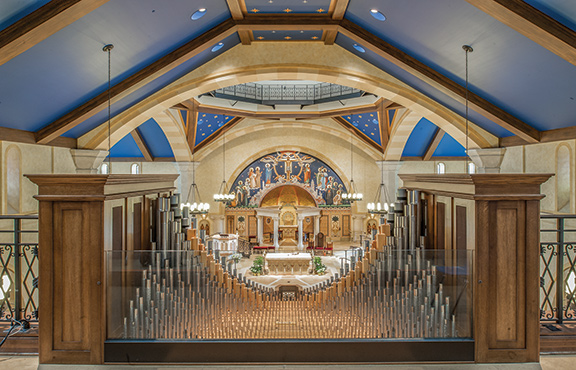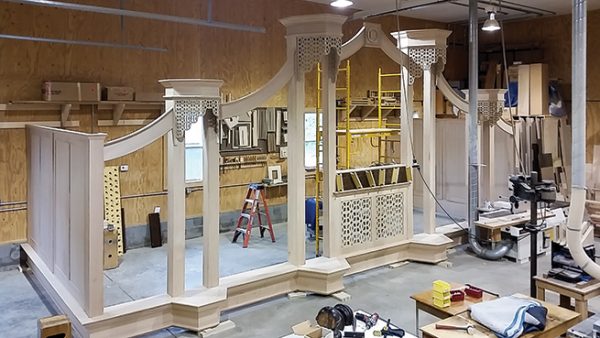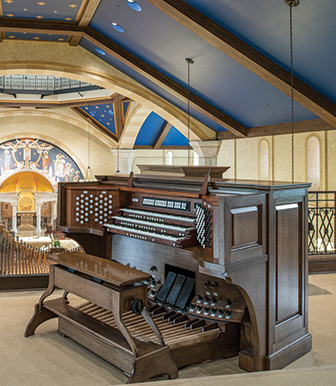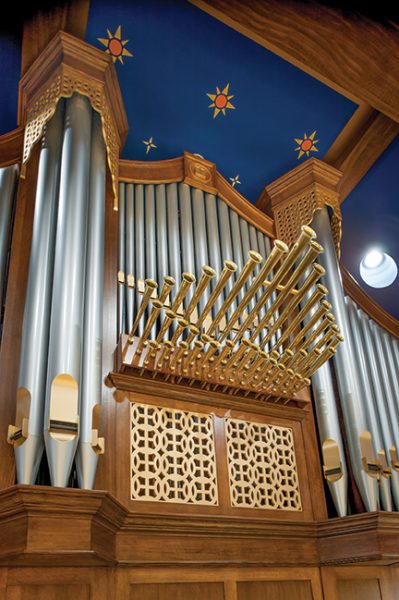St. Paul the Apostle Parish
Westerville, OH
Muller Pipe Organ Company • Croton, OH
By Scott G. Hayes and John W. Muller

The highlight of Muller Pipe Organ Company’s 95th anniversary year was the completion of the new pipe organ for St. Paul the Apostle Parish of Westerville, Ohio, the largest congregation in the Roman Catholic Diocese of Columbus. The music ministry at St. Paul is extensive and includes multiple parish choirs as well as music classes for children in the parochial school.
Our relationship with the parish began as the new building was being designed by David B. Meleca Architects. This early involvement afforded the sought-after opportunity for church, architect, and organbuilder to work collaboratively to create an acoustically reverberant and visually stunning space that is effective for both worship and music. The result is a handsome brick edifice seating approximately 1,500 parishioners.

The building project was also the catalyst for invaluable discussions between organbuilder and client. John Bryan, music director at St. Paul’s, explained how the organ would be used liturgically by the Parish. Paul Thornock, then diocesan organ consultant and director of music at St. Joseph Cathedral, provided valuable insight into the ways the organ would be utilized by the Diocese. Discussions resulted in an eclectic instrument that not only supports the diverse liturgies of the large parish, but also accommodates major diocesan events and plays a wide variety of organ repertoire.
The layout of the organ is informed by tradition. The Great, Swell, and Pedal divisions are housed in a case at the rear of the gallery. The Pedal surrounds the manual enclosures in “C and C-sharp” arrangement, as in many mechanical action instruments. The Positive is situated at the front of the gallery, suggestive of a European “Ruckpositiv” in both location and sound.
To ensure ample room for the numerous choir members in the balcony, it was necessary to locate one division on the rail. While not immediately apparent from photographs, there is significant distance between the main and railing cases; the division placed on the rail could easily overpower the divisions in the main case.
We decided to embrace the characteristics easily achieved (indeed, demanded) by location. Our tonal philosophy dictates a broad, warm sound for the Great division, and this was readily accomplished by a location in the main case, large scaling, higher wind pressure, and robust voicing. The desired effect for the Positive stresses articulate and bright sounds, effortlessly gained by a location on the railing, smaller scaling, lower wind pressure, and gentle voicing.

The Great is contained within a particularly expressive enclosure and functions as both “Great” and “Choir.” A broadly scaled and boldly voiced principal chorus is the cornerstone of the entire instrument. The smaller-scaled Violone was designed primarily as a 16′ stop, but plays at 8′ pitch and functions as the secondary Principal, being both brighter and more articulate. The Tromba is the darkest of the manual trumpets and employs English shallots and harmonic resonators beginning in the middle octave. Because the division is expressive, the Great includes ranks that would be expected in a Choir division: a throaty Clarinet and a pair of tapered Gemshorns.
The Swell is the workhorse of the organ and balances the Great division. A secondary principal chorus with a low-pitched mixture, an independent flute chorus, and broadly scaled Viole strings provide a solid platform for choral accompaniment. The Trompette and Clairon create a fiery “French” effect, yet do not possess parallel shallots with wide openings. Instead, they utilize shallots with medium openings that have a slight taper; the higher wind pressure of the division produces the bright tone. Conversely, the Hautbois features an open shallot to create the bright “French” quality, or nasality.
The Positive contains the most articulate and colorful stops of the organ and speaks authoritatively from a visually intriguing case on the gallery rail. The somewhat unconventional Quintaden provides a lovely solo voice and offers an alternative to the eloquent Gedeckt. The Positive Trompet is a median between the Great and Swell trumpets. These shallots were designed for effective tone on light wind pressure, providing plenty of power with ample fundamental tone.
The Pedal boasts a powerful Trombone as well as a reclaimed 16′ Open Wood Diapason. Like each manual division, the Pedal has a complete and independent principal chorus that culminates with a four-rank Mixture. To provide desired flexibility, the Pedal includes judicious borrowing from the manual divisions.

The visually and aurally commanding Pontifical Trumpet is mounted horizontally on the main case and is constructed of brass with flared resonators. This stop is the definitive solo voice of the organ. It is powerful enough to speak over fuller combinations, yet does so with a refined, even tone.
The cases were conceived to visually harmonize with the Romanesque features of the building. From the balcony, the outline of the Positive pipework mirrors the architecture of the ceiling and mural while drawing one’s focus directly to the liturgy at the front of the church. The casework and the console were fabricated by craftsmen at the Muller shop. The cases of quarter-sawn red oak were handcrafted using traditional joinery, as was the raised panel console. The console is movable and features interior accents of solid walnut with inlays of ebony and maple. Its low-profile design allows for a clean line of sight between the organist and the choir director.
We are especially grateful for the support of A.R. Schopp’s Sons (especially David Schopp for his guidance regarding reed stops), David R. Beck for sharing his expertise with scaling and voicing, Paul Thornock for his careful consideration as the consultant, and to countless others in the industry for their counsel and wisdom.
However, the instrument would not exist without the heroic efforts of John Bryan, the Reverend Charles Klinger, pastor, and the parishioners of St. Paul the Apostle. We thank them all for honoring us with the opportunity to be a part of this monumental project. The organ and church building are a lasting testimony to the faithfulness of this religious community.
Scott G. Hayes is tonal director of Muller Pipe Organ Company.
John W. Muller is president of Muller Pipe Organ Company.
THE ORGANBUILDERS
John Muller, Scott Hayes, Jack Muller, Mark Muller, Jane Muller, Stan Osborn, Jesse Braswell, Brad Ashbrook, Luke Tegtmeier, Justin Trimble, Jonathan Casady, Brett Greene



Fantastic! Also what is the piece played at 3:04 on the 4 minute documentary from the website?
Dear Donna,
According to the good folks at Muller, the piece is Dupre’s Prelude in B Major, Op. 7 No. 1.
Bill